European Union dehydrated vegetables sales are projected to grow from USD 16,296 million in 2025 to approximately USD 35,509 million by 2035, recording an absolute increase of USD 19,194 million over the forecast period. This translates into total growth of 117.8%, with demand forecast to expand at a compound annual growth rate (CAGR) of 8.1% between 2025 and 2035. The overall industry size is expected to grow by nearly 2.2X during the same period, supported by the accelerating shift toward convenient food solutions, increasing food preservation adoption, and developing applications across food manufacturing, foodservice operations, and retail channels throughout European economies.
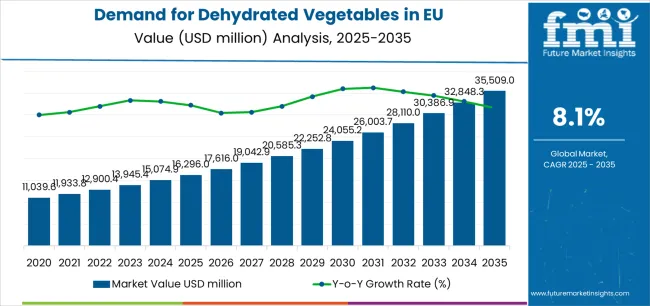
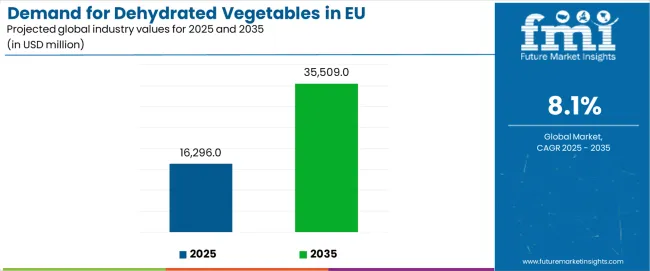
| Metric | Value |
|---|---|
| Market Value (2025) | USD 16,296 million |
| Market Forecast Value (2035) | USD 35,509 million |
| Forecast CAGR (2025-2035) | 8.1% |
Between 2025 and 2030, EU dehydrated vegetables demand is projected to expand from USD 16,296 million to USD 24,094 million, resulting in a value increase of USD 7,798 million, which represents 40.6% of the total forecast growth for the decade. This phase of development will be shaped by rising consumer adoption of convenient cooking solutions, increasing availability of diverse product varieties across onions, potatoes, carrots, and specialty vegetable formats, and growing mainstream acceptance of dehydrated vegetables across food manufacturing and foodservice channels. Manufacturers are expanding their product portfolios to address the evolving preferences for improved rehydration properties, authentic vegetable flavor profiles, and nutritionally preserved formulations comparable to fresh vegetables.
From 2030 to 2035, sales are forecast to grow from USD 24,094 million to USD 35,509 million, adding another USD 11,396 million, which constitutes 59.4% of the overall ten-year expansion. This period is expected to be characterized by further expansion of retail and online adoption, integration of advanced dehydration technologies for improved nutrient retention, and development of premium organic dehydrated varieties targeting health-conscious consumer segments. The growing emphasis on food security and increasing consumer willingness to purchase shelf-stable vegetable alternatives will drive demand for innovative dehydrated vegetable products that deliver authentic fresh vegetable experiences with extended shelf life.
Between 2020 and 2025, EU dehydrated vegetables sales experienced robust expansion at a CAGR of 7.2%, growing from USD 11,536.8 million to USD 16,296 million. This period was driven by increasing convenience consciousness among European consumers, rising awareness of food waste reduction benefits, and growing recognition of dehydrated vegetables' culinary advantages. The industry developed as major food companies and specialized dehydration processors recognized the commercial potential of shelf-stable vegetable alternatives. Product innovations, improved flavor preservation, and texture profile enhancements began establishing consumer confidence and mainstream acceptance of dehydrated vegetable products.
Industry expansion is being supported by the rapid increase in convenience-seeking consumers across European countries and the corresponding demand for shelf-stable, nutritionally preserved, and culinarily versatile vegetable solutions with proven functionality in cooking applications. Modern consumers rely on dehydrated vegetables as convenient alternatives to fresh vegetables in soup preparation, meal kit assembly, instant food production, and cooking occasions, driving demand for products that match or exceed fresh vegetables' functional properties, including rehydration behavior, flavor intensity, and nutritional retention. Even minor lifestyle factors, such as time constraints, storage limitations, or food waste concerns, can drive comprehensive adoption of dehydrated vegetables to maintain optimal convenience and support efficient meal preparation.
The growing awareness of food preservation benefits and increasing recognition of dehydrated vegetables' extended shelf life are driving demand for dehydrated vegetable alternatives from certified producers with appropriate quality credentials and processing standards. Regulatory authorities are increasingly establishing clear guidelines for dehydrated vegetable labeling, nutritional retention standards, and quality requirements to maintain consumer safety and ensure product consistency. Scientific research studies and nutritional analyses are providing evidence supporting dehydrated vegetables' nutrient preservation and functional advantages, requiring specialized dehydration methods and standardized processing protocols for authentic vegetable flavor development, optimal rehydration properties, and appropriate nutritional profiles, including vitamin retention and mineral preservation.
Sales are segmented by product type, application (end use), distribution channel, nature, and country. By product type, demand is divided into onions, potatoes, carrots, broccoli, and others. Based on application, sales are categorized into food manufacturers, foodservice, and retail. In terms of distribution channel, demand is segmented into hypermarkets/supermarkets, convenience stores, specialty stores, and online retail. By nature, sales are classified into organic and conventional. Regionally, demand is focused on Germany, France, Italy, Spain, the Netherlands, and the Rest of Europe.
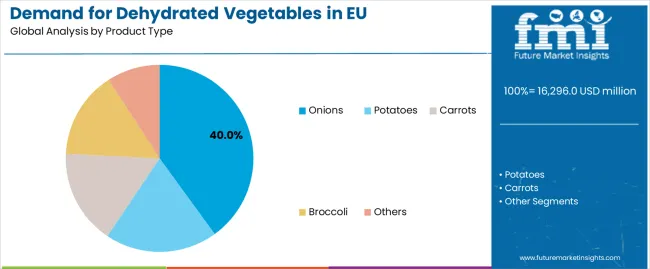
The onions segment is projected to account for 40% of EU dehydrated vegetables sales in 2025, declining slightly to 38% by 2035, establishing itself as the dominant product type across European operations. This commanding position is fundamentally supported by onions' universal culinary application, comprehensive flavor contribution across diverse dishes, and superior dehydration characteristics enabling long-term storage stability. The onions format delivers exceptional versatility, providing food manufacturers with a reliable ingredient that facilitates flavor development, cost reduction compared to fresh onions, and consistent quality essential for commercial food production.
This segment benefits from mature processing infrastructure, well-established supply chains, and extensive availability from multiple European and international suppliers who maintain rigorous quality standards and consistent processing protocols. Dehydrated onions offer versatility across various formats, including flakes, powder, granules, and chopped varieties, supported by proven dehydration technologies that address traditional challenges in flavor preservation and rehydration performance.
The onions segment is expected to maintain approximately 38% share through 2035, demonstrating stable positioning as alternative vegetables, including potatoes and specialty options, grow proportionally throughout the forecast period.
Key advantages:
.webp)
Food manufacturers are positioned to represent 53% of total dehydrated vegetables demand across European operations in 2025, maintaining approximately 52% share through 2035, reflecting the segment's dominance as the primary end-use application within the overall industry ecosystem. This considerable share directly demonstrates that food manufacturers represent the largest single application, with companies utilizing dehydrated vegetables for soup production, sauce formulation, snack manufacturing, and instant food development mirroring traditional ingredient usage patterns.
Modern food manufacturers increasingly view dehydrated vegetables as cost-effective, quality-consistent alternatives to fresh vegetables, driving demand for products optimized for industrial processing with appropriate rehydration properties, flavor profiles that meet formulation requirements, and specifications that ensure batch-to-batch consistency. The segment benefits from continuous innovation focused on improved nutrient retention, texture enhancement preventing mushiness after rehydration, and flavor development eliminating off-notes associated with early dehydrated vegetable formulations.
The segment's stable share reflects proportional growth across all application categories, with food manufacturers maintaining their leading position as the primary industrial buyer throughout the forecast period.
Key drivers:
Hypermarkets and supermarkets are strategically estimated to control 42% of total European dehydrated vegetables sales in 2025, declining slightly to 40% by 2035, reflecting the critical importance of mainstream retail for driving category accessibility and consumer trial. European retail operators consistently demonstrate growing shelf space allocation for dehydrated vegetables that deliver convenient storage, extended shelf life, and reliable quality across preparation methods.
The segment provides essential consumer access through prominent placement, promotional support driving trial purchases, and category expansion in mainstream retail environments where visibility optimizes product discovery and impulse buying. Major European retail chains, including Carrefour, Tesco, Edeka, and Aldi, systematically expand dehydrated vegetable selections, often featuring private-label offerings, organic varieties, and premium specialty products that normalize dehydrated vegetable usage and drive household penetration.
The segment's slight share decline reflects faster growth in online retail, which grows from 16% in 2025 to 22% in 2035, as e-commerce channels capture increasing consumer preference for home delivery and subscription models throughout the forecast period.
Success factors:
Conventional dehydrated vegetables are strategically positioned to contribute 82% of total European sales in 2025, declining to approximately 74% by 2035, representing products processed through standard dehydration methods without organic certification requirements. These conventional products successfully deliver accessible pricing and consistent quality while ensuring broad commercial availability across all retail channels and industrial operations that prioritize volume scalability and cost competitiveness over organic certification.
Conventional processing serves price-conscious consumers, mainstream food manufacturers, and large-volume foodservice operators, including quick-service restaurants, institutional catering, and industrial food producers that require reliable supply at competitive price points. The segment derives significant competitive advantages from established sourcing networks, economies of scale in processing, and the ability to meet substantial volume requirements from major buyers without organic certification constraints limiting raw material availability.
The segment's declining share through 2035 reflects the category's evolution toward premium organic products, which grow from 18% in 2025 to 26% in 2035, as health-conscious consumers and premium food manufacturers increasingly prioritize organic certification and natural processing methods.
Competitive advantages:
EU dehydrated vegetables sales are advancing rapidly due to accelerating convenience food adoption, growing food waste consciousness, and increasing recognition of shelf-stable vegetables' culinary advantages. The industry faces challenges, including persistent flavor and texture perceptions compared to fresh vegetables for quality-focused consumers, rehydration time requirements that limit spontaneous cooking applications, and competition from frozen vegetables offering similar convenience benefits. Continued innovation in dehydration technologies and flavor preservation optimization remains central to industry development.
The rapidly accelerating development of advanced dehydration technologies is fundamentally transforming vegetable processing from traditional hot-air drying to sophisticated methods including freeze-drying, vacuum dehydration, and infrared processing, enabling superior nutrient retention previously unattainable through conventional dehydration. Advanced processing platforms featuring controlled temperature protocols, reduced oxygen environments, and rapid moisture removal allow processors to create dehydrated vegetables with authentic color preservation, characteristic texture after rehydration, and genuine flavor development comparable to fresh vegetables. These technology innovations prove particularly transformative for premium applications, including organic retail products, gourmet food manufacturing, and health-focused meal kits, where nutritional quality and sensory properties prove essential for consumer acceptance.
Major dehydrated vegetable producers invest heavily in processing technology upgrades, pilot-scale equipment testing, and quality optimization for nutrient preservation, recognizing that advanced dehydration represents breakthrough solutions for quality perception challenges limiting mainstream adoption. Manufacturers collaborate with equipment suppliers, food scientists, and research institutions to develop scalable processing systems that reduce energy consumption while maintaining quality standards supporting premium positioning and mainstream penetration.
Modern dehydrated vegetable producers systematically incorporate organic certification programs, including agricultural partnerships with organic farms, supply chain traceability systems, and processing protocols that deliver organic-certified products, clean ingredient lists, and transparent manufacturing processes supporting premium positioning. Strategic integration of organic production optimized for health-conscious consumers enables manufacturers to position dehydrated vegetables as natural alternatives to conventional options where certification directly determines purchasing behavior and brand loyalty. These quality improvements prove essential for retail specialty adoption, as premium consumers demand organic certification, non-GMO verification, and additive-free processing supporting wellness priorities.
Companies implement extensive supplier qualification programs, organic certification maintenance partnerships with certifying bodies, and production optimization targeting specific quality attributes, including pesticide-free raw materials, natural processing methods, and minimal intervention approaches. Manufacturers leverage organic positioning in marketing campaigns, retail shelf differentiation, and packaging featuring certification logos, positioning organic dehydrated vegetables as premium alternatives delivering health benefits and environmental responsibility.
European consumers increasingly prioritize sustainably sourced dehydrated vegetables featuring local agricultural partnerships, energy-efficient processing methods, and transparent supply chains that align with environmental values. This focus enables manufacturers to differentiate premium offerings through regional sourcing claims, renewable energy usage, and carbon footprint reduction supporting environmental positioning. Sustainable production proves particularly important for retail organic applications where environmental credentials require supply chain verification and processing transparency supporting consumer trust.
The development of energy-efficient dehydration methods, including solar drying integration, waste heat recovery systems, and renewable energy adoption expands manufacturers' abilities to create environmentally responsible products delivering commercial viability without excessive environmental impact. Brands collaborate with agricultural cooperatives, equipment manufacturers, and certification bodies to develop operations balancing environmental objectives with cost competitiveness, supporting marketing claims and premium positioning while maintaining economic viability across competitive segments.
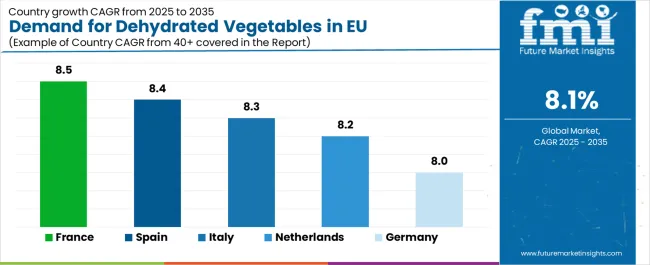
| Country | CAGR % (2025–2035) |
|---|---|
| France | 8.5% |
| Spain | 8.4% |
| Italy | 8.3% |
| Netherlands | 8.2% |
| Germany | 8% |
EU dehydrated vegetables sales demonstrate robust growth across major European economies, with Rest of Europe leading expansion at 8.8% CAGR through 2035, driven by food manufacturing growth and increasing retail adoption. Germany maintains leadership through established processing infrastructure and strong industrial demand. Italy benefits from culinary tradition supporting dehydrated vegetable usage. Spain shows steady growth supported by agricultural production intensity and processing investments. The Netherlands emphasizes technological innovation and efficient logistics. Rest of Europe demonstrates solid expansion reflecting emerging operations development. Overall, sales show strong regional development reflecting EU-wide consumer shifts toward convenient food solutions and dehydrated vegetable acceptance.
Revenue from dehydrated vegetables in Germany is projected to exhibit steady growth with a CAGR of 8% through 2035, driven by exceptionally well-developed food manufacturing base, comprehensive dehydration processing infrastructure, and strong industrial demand for cost-effective vegetable ingredients throughout the country. Germany's sophisticated food industry and internationally recognized leadership in processing technology are creating substantial demand for diverse dehydrated vegetable varieties across all industrial segments.
Major food manufacturers, including Knorr operations, soup producers, and instant food companies, systematically expand dehydrated vegetable procurement, often establishing long-term supply contracts and quality specifications. German demand benefits from high processing sophistication, substantial industrial scale supporting volume requirements, and technical expertise that naturally supports dehydrated vegetable adoption across mainstream food production beyond specialty applications.
Growth drivers:
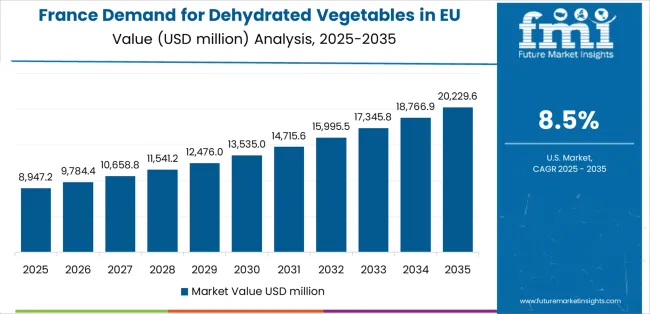
Revenue from dehydrated vegetables in France is expanding at a leading CAGR of 8.5%, substantially supported by growing food manufacturing sector, increasing retail penetration, and evolving consumer attitudes toward convenient cooking solutions despite France's strong fresh food culture. France's expanding convenience food adoption among urban consumers and increasing time-pressure awareness are systematically driving demand for high-quality dehydrated vegetables across diverse consumer segments.
Major retailers, including Carrefour, Auchan, and Leclerc, gradually establish comprehensive dehydrated vegetable sections featuring organic options, premium varieties, and private-label offerings. French sales particularly benefit from sophisticated culinary culture that demands superior quality standards, driving product innovation and premiumization within the dehydrated vegetables category. Consumer education initiatives and chef endorsements significantly enhance penetration rates despite historical preference for fresh vegetables.
Success factors:
Revenue from dehydrated vegetables in Italy is growing at a robust CAGR of 8.3%, fundamentally driven by culinary tradition supporting vegetable usage, concentrated food processing operations, and gradual consumer acceptance of convenient alternatives. Italy's traditionally vegetable-rich cuisine is increasingly accommodating dehydrated options as consumers recognize time-saving benefits and quality improvements in modern dehydrated products.
Major food manufacturers, including pasta sauce producers, soup companies, and ready-meal operators, strategically expand dehydrated vegetable integration for cost efficiency and consistency. Italian sales particularly benefit from strong food manufacturing concentration creating industrial demand, combined with retail development featuring organic dehydrated vegetables appealing to health-conscious consumers in Milan, Rome, and other urban centers.
Development factors:
Demand for dehydrated vegetables in Spain is projected to grow at a CAGR of 8.4%, substantially supported by intensive agricultural production providing raw material availability, expanding dehydration processing investments, and increasing food manufacturing demand. Spanish agricultural sector's efficiency positions domestic dehydration operations for competitive advantage through integrated supply chains.
Major food producers, agricultural cooperatives, and emerging dehydration facilities systematically develop processing capacity, with some regional operations proving particularly successful in export-oriented production. Spain's substantial vegetable production ensures consistent raw material supply, supporting viable dehydration operations and encouraging infrastructure investments.
Growth enablers:
Demand for dehydrated vegetables in the Netherlands is expanding at a CAGR of 8.2%, fundamentally driven by strong technological capability, efficient logistics infrastructure, and comprehensive food industry integration. Dutch food processors and dehydration operators demonstrate particularly high processing efficiency and quality standards.
Netherlands sales significantly benefit from advanced processing technology adoption, strategic location supporting European distribution, and innovative food industry collaborating on product development. The country's compact geography facilitates efficient raw material sourcing, while technical expertise enables advanced dehydration implementation. The Netherlands also serves as distribution hub for European dehydrated vegetable trade, with major operations serving broader European customers.
Innovation drivers:
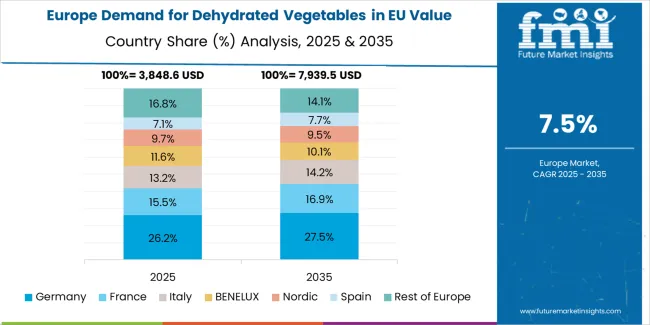
EU dehydrated vegetables sales are projected to grow from USD 16,296 million in 2025 to USD 35,509 million by 2035, registering a CAGR of 8.1% over the forecast period. France is expected to demonstrate the strongest growth trajectory among major countries with an 8.5% CAGR, supported by food manufacturing expansion, increasing retail penetration, and growing culinary adoption. Germany, Italy, Spain, Netherlands, and Rest of Europe follow with 8.2% CAGR each, reflecting strong industrial demand and retail development.
Germany maintains the largest share at 32.7% in 2025, driven by robust food manufacturing infrastructure and established dehydration processing capabilities. France holds 21.5% share, while Italy accounts for 16.8%, supported by culinary traditions and food processing concentration.
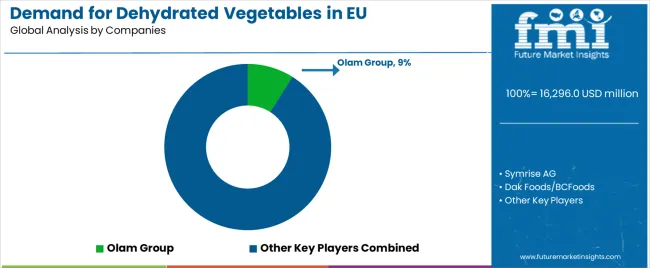
EU dehydrated vegetables sales are defined by competition among multinational food ingredient suppliers, specialized dehydration processors, and regional agricultural cooperatives. Companies are investing in dehydration technologies, processing efficiency optimization, organic certification programs, and quality standardization to deliver high-quality, nutritionally preserved, and cost-competitive dehydrated vegetable solutions. Strategic partnerships with food manufacturers, retail distribution expansion, and marketing campaigns emphasizing quality improvements and nutritional retention are central to strengthening competitive position.
Major participants include Olam Group with an estimated 9% share, leveraging its agricultural expertise, global sourcing network, and established European presence, supporting consistent raw material supply to dehydration operations. Olam benefits from integrated supply chains, processing infrastructure investments, and ability to provide diverse vegetable varieties, supporting customer requirements across food manufacturing and retail segments.
Symrise AG holds approximately 6% share, emphasizing German-based processing capability, flavor ingredient expertise, and quality positioning across European customers. Symrise's success in developing high-quality dehydrated vegetables with superior flavor profiles creates strong positioning and industrial acceptance, supported by technical service capabilities and application development support.
Dak Foods/BCFoods accounts for roughly 4% share through its position as specialized processor serving spice-blend manufacturers, seasoning companies, and food ingredient distributors. The company benefits from processing specialization, established customer relationships, and comprehensive product portfolio supporting diverse applications.
Other companies collectively hold 81% share, reflecting the highly fragmented nature of European dehydrated vegetables sales, where numerous regional processors, agricultural cooperatives, private-label suppliers for major retailers, and specialized organic producers serve local operations, specific customer requirements, and niche applications. This fragmentation provides opportunities for differentiation through specialized processing capabilities (freeze-drying, organic certification), regional sourcing advantages, innovative product formats, and premium positioning resonating with quality-focused customers.
| Item | Value |
|---|---|
| Quantitative Units | USD 35,509 million |
| Product Type | Onions, Potatoes, Carrots, Broccoli, Others |
| Application (End Use) | Food Manufacturers, Foodservice, Retail |
| Distribution Channel | Hypermarkets/Supermarkets, Convenience Stores, Specialty Stores, Online Retail |
| Nature | Organic, Conventional |
| Countries Covered | Germany, France, Italy, Spain, the Netherlands, and the Rest of Europe |
| Key Companies Profiled | Olam Group, Symrise AG, Dak Foods/BCFoods, Regional processors |
| Additional Attributes | Dollar sales by product type, application (end use), distribution channel, and nature; regional demand trends across major European economies; competitive landscape analysis with established ingredient suppliers and specialized dehydration processors; industrial and consumer preferences for various vegetable types and formats; integration with advanced dehydration technologies and freeze-drying development; innovations in nutrient retention optimization and flavor preservation; adoption across food manufacturing and retail channels; regulatory framework analysis for dehydrated vegetable standards and food safety compliance; supply chain strategies; and penetration analysis for mainstream industrial and premium organic European applications. |
The global demand for dehydrated vegetables in EU is estimated to be valued at USD 16,296.0 million in 2025.
The market size for the demand for dehydrated vegetables in EU is projected to reach USD 35,509.0 million by 2035.
The demand for dehydrated vegetables in EU is expected to grow at a 8.1% CAGR between 2025 and 2035.
The key product types in demand for dehydrated vegetables in EU are onions, potatoes, carrots, broccoli and others.
In terms of application (end use), food manufacturers segment to command 53.0% share in the demand for dehydrated vegetables in EU in 2025.






Our Research Products

The "Full Research Suite" delivers actionable market intel, deep dives on markets or technologies, so clients act faster, cut risk, and unlock growth.

The Leaderboard benchmarks and ranks top vendors, classifying them as Established Leaders, Leading Challengers, or Disruptors & Challengers.

Locates where complements amplify value and substitutes erode it, forecasting net impact by horizon

We deliver granular, decision-grade intel: market sizing, 5-year forecasts, pricing, adoption, usage, revenue, and operational KPIs—plus competitor tracking, regulation, and value chains—across 60 countries broadly.

Spot the shifts before they hit your P&L. We track inflection points, adoption curves, pricing moves, and ecosystem plays to show where demand is heading, why it is changing, and what to do next across high-growth markets and disruptive tech

Real-time reads of user behavior. We track shifting priorities, perceptions of today’s and next-gen services, and provider experience, then pace how fast tech moves from trial to adoption, blending buyer, consumer, and channel inputs with social signals (#WhySwitch, #UX).

Partner with our analyst team to build a custom report designed around your business priorities. From analysing market trends to assessing competitors or crafting bespoke datasets, we tailor insights to your needs.
Supplier Intelligence
Discovery & Profiling
Capacity & Footprint
Performance & Risk
Compliance & Governance
Commercial Readiness
Who Supplies Whom
Scorecards & Shortlists
Playbooks & Docs
Category Intelligence
Definition & Scope
Demand & Use Cases
Cost Drivers
Market Structure
Supply Chain Map
Trade & Policy
Operating Norms
Deliverables
Buyer Intelligence
Account Basics
Spend & Scope
Procurement Model
Vendor Requirements
Terms & Policies
Entry Strategy
Pain Points & Triggers
Outputs
Pricing Analysis
Benchmarks
Trends
Should-Cost
Indexation
Landed Cost
Commercial Terms
Deliverables
Brand Analysis
Positioning & Value Prop
Share & Presence
Customer Evidence
Go-to-Market
Digital & Reputation
Compliance & Trust
KPIs & Gaps
Outputs
Full Research Suite comprises of:
Market outlook & trends analysis
Interviews & case studies
Strategic recommendations
Vendor profiles & capabilities analysis
5-year forecasts
8 regions and 60+ country-level data splits
Market segment data splits
12 months of continuous data updates
DELIVERED AS:
PDF EXCEL ONLINE
Western Europe Dehydrated Vegetables Market Analysis by Product Type, Form, Nature, End Use, Technology, Distribution Channel, and Country Through 2025 to 2035
Europe Dehydrated Onions Market Analysis – Growth, Trends & Forecast 2025-2035
Demand for Dehydrated Onions in EU Size and Share Forecast Outlook 2025 to 2035
Europe Radiotherapy Patient Positioning Market Size and Share Forecast Outlook 2025 to 2035
Dehydrated Garlic Market Size and Share Forecast Outlook 2025 to 2035
Dehydrated Skin Product Market Forecast Outlook 2025 to 2035
Europe Polyvinyl Alcohol Industry Analysis Size and Share Forecast Outlook 2025 to 2035
Europe Cruise Market Forecast and Outlook 2025 to 2035
Europium Market Forecast and Outlook 2025 to 2035
Eucommia Leaf Extract Market Size and Share Forecast Outlook 2025 to 2035
Europe Massage Therapy Service Market Size and Share Forecast Outlook 2025 to 2035
Europe Cement Market Analysis Size and Share Forecast Outlook 2025 to 2035
European Union Tourism Industry Size and Share Forecast Outlook 2025 to 2035
Europe Injection Molding Machines Market Size and Share Forecast Outlook 2025 to 2035
Europe Injection Moulders Market Size and Share Forecast Outlook 2025 to 2035
Europe and MENA Generic Oncology Drug Market Size and Share Forecast Outlook 2025 to 2035
Europe Masking Tapes Market Size and Share Forecast Outlook 2025 to 2035
Europe Liners Market Size and Share Forecast Outlook 2025 to 2035
Europe Dermal Fillers Market Size and Share Forecast Outlook 2025 to 2035
Dehydrated Onions Market Analysis - Size, Share, and Forecast Outlook 2025 to 2035

Thank you!
You will receive an email from our Business Development Manager. Please be sure to check your SPAM/JUNK folder too.
Chat With
MaRIA